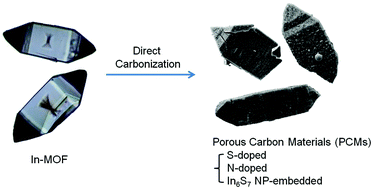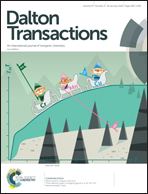In6S7 nanoparticle-embedded and sulfur and nitrogen co-doped microporous carbons derived from In(tdc)2 metal–organic framework†
Abstract
Indium sulfide nanoparticle (NP)-embedded microporous carbons co-doped with S- and N-dopants are easily prepared by a direct carbonization of the as-prepared In(III)-based metal–organic framework (In-MOF), [Et2NH2][In(tdc)2]·DEF, containing ditopic S-containing 2,5-thiophenedicarboxylate (tdc2−) bridging linkers as a potential source of S-dopant. The charge on the anionic framework of [In(tdc)2]− is balanced by Et2NH2+, which is also a potential N-dopant. Simultaneous embedding of In-based NPs, S-, and N-co-doping is achieved in a simple single step carbonization of In-MOF. Three porous carbon materials (PCMs), PCM-700, PCM-800, and PCM-900, are obtained from the carbonization of In-MOF at 700, 800, and 900 °C, respectively. The gas sorption analysis indicates them as good CO2 sorbents. The photocatalytic degradation of methyl orange by PCMs under visible light irradiation is also effectively operable owing to the photocatalytically active semiconducting indium sulfide NP with a small bandgap. The main component of indium sulfide NPs is revealed as In6S7 based on the powder X-ray diffraction pattern. Small amounts of metallic In and In2S3 are also observed. The specific capacitances of PCMs are also estimated from the galvanostatic charge/discharge curves. PCM-900 exhibits the highest gravimetric specific capacitance of 99.0 F g−1 at a current density of 0.05 A g−1.



 Please wait while we load your content...
Please wait while we load your content...